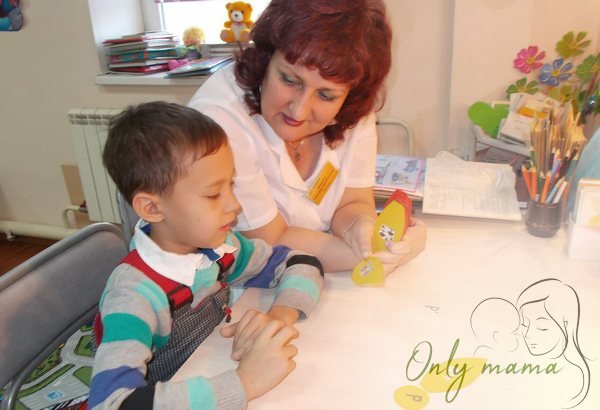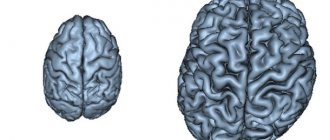The first months and years of a child are a time of amazing discoveries and important events for both him and his loved ones.
Every stage in development is tracked - sounds, emotions, words, steps. Sometimes it seems that other children develop faster and can do more. And anxious parents run to doctors, look for information in books and the Internet. Most often, after some time, the baby catches up with everything and after 2-3 years is no longer different from peers who were once ahead of him in terms of development standards.
And if some emotional and behavioral characteristics can be attributed to childhood, then during the period of preparation for school and at the beginning of education, the lag becomes obvious.
But symptoms of mental retardation even in a tiny baby indicate the presence of some problems in his internal or external world.
ZPR in children: definition and signs
Mental retardation is characterized by a child’s delay in the mental, emotional, and mental areas. It manifests itself as a violation of cognitive processes: thinking, memory, attention. This gives rise to difficulties in the educational process, which becomes noticeable at the stage of preschool education or in the primary grades, when children enter a new stage of development.
Some mental development disorders in children may be noted by parents or educators at an earlier age. However, diagnosis of mental retardation is carried out during the period when the child begins to develop serious mental activity, usually from 5-6 years of age. It is necessary to make a diagnosis and begin correction before the age of 7-8 years.
In some cases, mental retardation is noted in infancy. The child later begins to be interested in toys, babble, understand speech, etc. Physical development is not affected.
Often preschoolers and schoolchildren with mental retardation are called frivolous. Children are excessively forgetful, distracted, distracted from the topic and disturb others. During lessons, such children can talk about something of their own, walk or play. They are often slow and confused, unable to concentrate and concentrate their thoughts. Children's performance and verbal-logical thinking suffer, and cause-and-effect relationships are disrupted.
One should also suspect mental retardation if a first-grader
- does not understand the rules of children's games;
- has difficulty mastering counting, reading, and writing;
- forgets about the purpose of his activity, impulsively changes plans, does not maintain attention on the task;
- experiences emotional and even physical torment due to unusual mental activity;
- unable to learn the rules of behavior in various situations;
- shows inappropriate emotions (hysterics when trying to divide an item, laughter in a solemn or dramatic setting);
- has difficulty communicating with peers;
- silent, not independent in everyday life.
Classification and types of ZPR
To classify mental retardation in children, it is important to take into account the reasons that led to the formation of this pathology. In pediatrics, there are four main types of this disease, each of which has its own characteristics and is a key factor in finding an effective treatment method.
Important
Most often, mental retardation is a reversible disorder; in rare cases, pathology formed on the basis of genetic preconditions cannot be corrected.
The classification of ZPR is presented as follows:

ZPR of psychogenic origin. In this case, we are talking about unfavorable living conditions and raising a child, neglect or overprotection. Some parents literally go to extremes when it comes to their children. They begin to either put pressure on the child with their guardianship, believing that in this way they show their care and ensure safety. The second extreme can be considered the lack of minimal control. In such situations, parents justify themselves by the desire to develop independence in the child.- ZPR of constitutional origin. This type in medicine is also called harmonic psychophysical infantilism. Here hereditary predisposition plays an important role, that is, infantilism also occurs in other family members, but does not reach a pathological level. For such children, the characteristic features are: expressive gestures and lively facial expressions, limitations of interests to play activities, a developmental lag of 1.5-2 years from their peers.
- ZPR of cerebral-organic origin. Children with this type of mental retardation are characterized by the presence of organic insufficiency of the nervous system of mild severity. Most often, the cause of the formation of this type of ZPR is pregnancy pathologies, among which are: severe toxicosis, prematurity, infections, asphyxia, diseases with complications in the first year of life.
- ZPR of somatogenic origin. This type of mental retardation is characterized by a slowdown in mental development with a simultaneous loss of acquired skills and a return to earlier forms of behavior. It is as a result of long-term and severe illnesses that one can observe not only a lack of progress in development, but also some regression. In society, such children are usually called “home children.” Their social circle is very limited, since they are quite closed and have problems communicating with peers. Children with mental retardation of the self-genic type are characterized by increased fatigue and exhaustion, lability, asthenia and impaired attention.
Important
A particular danger of mental retardation is that one of its complications is the risk of developing autism. Medical practice shows that it is completely impossible to cure autism, since there are no effective methods of treating this particular pathology.
Types of mental retardation in children
Some children with mental retardation demonstrate absolute disobedience, make noise and disrupt lessons, they are little concerned about failure, although they grasp something on the fly. Other children, on the contrary, prefer to remain unnoticed and can study averagely thanks to diligent cramming.
Applicable to the first type, it is appropriate to talk about retardation in the development of the child’s emotional-volitional sphere. It is precisely these children who have difficulties with discipline, self-criticism, and concentration. In any situation, children with developmental delays give preference to games and pampering. There is no motivation to achieve. The mental development of such children lags behind on average by 2-3 years.
Children suffering from mental retardation of the second type, exemplary silent people, are more likely to experience a delay in the mental area. Children often cannot express in words even the knowledge they have. They are afraid to ask questions and ask for help, they miss the thread of the plot. Unlike peers of the first type, failures are difficult to experience. They would be happy to study well, but they cannot.
There is another popular classification of types of mental retardation in children.
Moreover, a similar condition in a more restrained form also occurs in adults who did not receive timely treatment.
- Constitutional ZPR. This includes immature individuals, with “childish” thinking, they speak slowly, think, make decisions, do anything. There is little that can truly captivate and interest them, except for what gives pleasure “here and now.” Children of this type are sociable, but at the same time they are attached to their parents and have difficulty adapting to a new environment.
- Somatogenic delay. Children are whiny and dependent on approval. They find it difficult to make contact and can be outcasts in the team. Against the backdrop of emotional stress, children experience physical ailments.
- Psychogenic mental retardation. This is a completely acquired condition. It manifests itself as a decrease in intelligence in children, inattention, anxiety and infantilism. Emotions are superficial, horizons are narrowed;
- ZPR is a cerebral-organic phenomenon. There is damage to the brain areas, which often makes the child unbalanced, capricious, and conflict-ridden. The cognitive, communicative, and emotional spheres of children suffer. Severe speech development disorders occur.
It is important to differentiate between mental retardation, in which the prognosis is very good, and mental retardation in children, which manifests itself not so much as a delay, but as a general mental underdevelopment.
The success of overcoming mental retardation in children depends primarily on timely diagnosis, correct identification of the root cause and an integrated approach.
Classification of causes of mental retardation
The term “mental retardation” was introduced by G.E. Sukhareva. It is understood as a lack of knowledge, insufficient maturity of thinking, predominance of games, lack of perseverance and rapid fatigue from intellectual work. Delay in mental development should not be confused with mental retardation. This process is reversible, and with adequate help from specialists, the problem is completely eliminated.

There are several reasons for developmental delay. Classification of ZPR by Sukhareva G.E. identifies three main factors influencing mental retardation:
- Hereditary diseases;
- Intrauterine pathology of the embryo;
- Trauma at birth.
Pevzner M.S. and Vlasova T.A. The following types of causes of developmental delay were identified:
- Complicated pregnancy associated with infections, toxicosis, poisoning of the body with drugs, alcohol, drugs, incompatibility of Rh factors in the blood of the mother and fetus;
- Injuries during the passage of the birth canal and asphyxia of infants;
- Social disadvantage due to limited contact with the outside world or an unfavorable family situation.
With this classification of causes, children with delayed developmental disabilities grow up without parental control or in conditions of excessive care, when there is a lack of communication with elders and peers. Another reason for developmental delays is hearing, vision and speech defects.

Reasons for the formation of the ZPR
The etiology of mental development disorders includes two components: social factors in the lives of children and biological ones. Biological ones include:
- delays in the rate of brain maturation in the perinatal period and in early childhood;
- pathologies during pregnancy: intrauterine infections, hypoxia, bad habits of the mother, her emotional instability, atypical toxicosis, birth injuries;
- severe infectious diseases suffered by the baby, traumatic brain injuries, intoxication;
- A defect in one or more sense organs and, as a consequence, limited interaction with the world;
- heredity. Often, undiagnosed and uncorrected mental retardation in the mother or father subsequently manifests itself in the child.
Problems of mental development of the cerebral-organic type are most often due to biological reasons.
The socio-psychological prerequisites for mental retardation lie in the approach to raising a child. He experiences either overprotection or a lack of care and love from his parents. Sometimes a child becomes a witness or victim of traumatic situations and withdraws into himself, thereby blocking the functioning of the brain and suppressing cognitive activity. The lag is also provoked by pedagogical neglect and the lack of positive examples before the child’s eyes. ZPR is often observed in children in not the most prosperous families.
Constitutional, somatogenic and psychogenic mental retardation are based on social and hereditary prerequisites. If one of the parents had mental development disorders, most likely this will affect their children, including through the manner of upbringing and general behavior in the child’s family.
Diagnosis and treatment of mental retardation
Mental development disorder is not a specific diagnosis, but a general designation for any disorders associated with the mental development of a child. The following groups of disorders are classified according to ICD-10:
- Speech and language. These include problems with spelling, reading, verbal communication, pronunciation;
- Study skills. A 7-year-old cannot cope with the minimum mental load in the preparatory group and school;
- Motor functions. The child has difficulty with everyday functions (getting dressed, setting the table, eating on his own), and coordination of movements is impaired.
If the symptoms cannot be attributed to one of the groups, a general or mixed mental disorder is diagnosed.
Additionally, a diagnosis of ADHD may be assigned, since mental retardation is often accompanied by attention disorder or hyperactivity. In the same child, different specialists may suspect both a mental development disorder and ADHD.
Therefore, a diagnosis associated with mental retardation is made only by a psychological-medical-pedagogical commission, to which, as a rule, an educational institution refers. For diagnostic purposes, various questionnaires and tasks are used that correspond to a certain age of the child.
The commission determines a list of classes with a speech therapist, psychologist, defectologist, etc. or gives a referral to a special school. If necessary, the child is referred to a neurologist or child psychiatrist to prescribe medication for mental retardation. As a rule, these are either ineffective drugs or brain stimulants with a number of side effects.
Family psychotherapy with the participation of the child’s family gives excellent results. Here the psychological factors of mental retardation are identified.
Caused by external causes, mental retardation can be easily corrected in children, and by middle age the child is actually comparable in development to his peers. Mental development disorders caused by damage to the cerebral cortex and central nervous system are more severe and require medical attention.
In exceptional cases, hardware diagnostic methods are used, for example, EEG, but only if epilepsy or other diseases of the brain structures are suspected.
Echoes of mental retardation in adulthood
A child with mental retardation without serious organic disorders can communicate in a team, get an education and profession, work and start a family. But in almost all areas of life he is accompanied by difficulties. Childhood mental retardation transforms into other diagnoses as they grow older.
People with a mild form of mental retardation do not stand out from the general mass. They are plagued by problems with motivation and goal setting, they constantly doubt or commit rash acts. They rarely achieve success in life. Often lazy and inert. They are infantile in interpersonal relationships, have little initiative in business, and are prone to emotional instability. They suffer greatly from failures and from their condition.
More severe mental development disorders in children over the years turn them into dependent, withdrawn people who need constant monitoring and mentoring, help in everyday life, at work and in building relationships. In other words, they go with the flow. They do not experience developmental needs.
CPR in adults is often accompanied by a number of chronic diseases, congenital or acquired, as well as psychosomatic. They are unable to take care of their health, analyze their lifestyle, or replace bad habits with productive ones. In essence, this is an adult “child”.
Osteopathic approach to the treatment of mental retardation.
Finding and eliminating the root cause is the principle of work of an osteopathic doctor. The main idea of osteopathy is that a healthy body is able to get rid of the disease itself or mitigate its symptoms. To do this, it must be brought into a state of balance by restoring all structures. An osteopath works with patients from infants in their first days of life to the very elderly.
A postpartum session with a specialist can prevent the child from experiencing mental retardation in the future. A baby at risk requires special attention. According to a medical report, he may be absolutely healthy, but certain factors are a reason to show him to an osteopath: problems during pregnancy, general illnesses of the mother, traumatic birth. Osteopathic treatment is also indicated for premature and weakened children after their condition has normalized.
If during pregnancy the mother suffered acute infectious diseases, experienced stress, or has cardiovascular and other pathologies, the child is more likely to develop hypoxia, which worsens during childbirth. Oxygen starvation subsequently causes mental retardation in children.
Why is it not necessary to wait for osteopathic correction until school age or even one year of age, when the disorders manifest themselves?
The fact is that in a newborn baby, the doctor is able to completely eliminate the causes of future developmental disorders in one session. To prevent mental retardation in growing children, several appointments will be required, and at school age the body will adapt to the pathology, so long-term therapy will be needed with long time intervals for adjustment.
If a child was born as a result of a caesarean section or obstetrics, most likely his skull and cervical bones are displaced, which interferes with adequate blood supply to the brain. Such injuries to the baby are not diagnosed by hardware, but they greatly impair the quality of life and can provoke mental retardation.
An osteopath examines a patient with his hands. Clamps are eliminated, making room for free blood circulation. In the arsenal of osteopathy there are techniques that promote the outflow of venous blood from brain structures and reduce intracranial pressure.
A follow-up visit to an osteopath is also necessary in cases where a well-developing baby has suffered injuries, falls, or infections - after the completion of the acute phase, he needs recovery. The specialist will eliminate spasms and muscle tension, which are especially dangerous in the head area, and normalize blood and lymph flow as a preventive measure for mental retardation.
Why is it impossible to detect hidden diseases that contribute to mental retardation in children using modern diagnostic tools?
The fact is that the body turns on defense mechanisms. In order to survive, he uses internal resources to the maximum, and these are tensions, spasms, shifts of body elements. The child survives at the cost of delayed emotional, mental, and intellectual development.
And osteopathy is a branch of medicine that can remove a child’s body from a protective-compensatory state and launch development.
Psychological developmental disorders in children (page 1 of 2)
Problem 1.
Natasha S, 3 years old, is being examined in a psychiatric hospital to determine her place of further stay.
From the medical history it is clear that the mother left the child in the maternity hospital, the father is unknown. During the first year of her life, Natasha suffered from rickets and was stunted in height and weight. She suffered from measles, chicken pox, and pneumonia twice. A therapeutic examination revealed retardation in height and weight, and dysbacteriosis. Currently, the girl must be transferred from the Children's Home to the Children's Home. She walks, eats independently, and uses two- or three-word phrases.
During a clinical examination, Natasha is accessible to contact, follows simple instructions, and can pick up and put down various toys upon request. Knows the names of body parts and can show them. Speech is poorly developed, but with assistance it is possible to repeat a phrase of 3-4 words.
Compiling a story from pictures is not possible, nor is retelling the text. Drawing at the scribble level. Emotional reactions are lively, adequate, and dependent on encouragement. Expressed exhaustion and instability of attention. When conducting a learning experiment, it is possible to assimilate and transfer methods of action.
1.What developmental disorder can be suspected?
According to the development table (see appendix), the girl may be delayed due to illnesses suffered at an early age and insufficient attention in the early stages of her development.
But this lag can be easily overcome with the proper level of organization of the educational process.
2. What type of preschool should a girl attend?
The girl can be placed in a regular kindergarten, but given special attention and individual lessons with her
Problem 2.
Kostya B., 7 years old, is undergoing examination to determine school readiness. According to the mother, it is known that the child was born on time, lagged behind in early development: he could hold his head at 4 months, learned to sit by 9 months, and walk at 1 year and 5 months. Individual words appeared by 2 years, phrasal speech by 4 years. I didn’t follow the curriculum in kindergarten. By now, the child knows individual letters and can name numbers from 1 to 10.
At the reception, the child has difficulty making contact and is not interested in tasks and toys.
Performance is uniformly low. The pace of sensorimotor is slow. Rote memorization successful: 5, 7, 7, 10; indirect associative memory is much worse. Simple generalizations are available: “food”, “dishes”; more complex ones are impossible. The stock of knowledge is insufficient. The subject does not know the name and profession of his parents, or his home address.
Constructive praxis is inaccessible, the drawing of a person is at the “head-foot” level. Account unavailable.
Establishing a connection and sequence of events in a series of 2 paintings - with the help. There is no response to assistance or encouragement. Criticality towards achievements is undeveloped, self-esteem is not formed.
1.What type of impaired mental development is noted in this case?
In this case, this is oligophrenia, since the phenomena of general irreversible underdevelopment of cerebral structures prevail with a predominant violation of the ontogenesis of the most complex and late-forming cortical systems, primarily the frontal cortex.
As is known, the basis of the defect is made up of two factors: the totality and hierarchy of underdevelopment of the brain and the body as a whole.
Totality manifests itself, first of all, in the organic underdevelopment of all neuropsychic functions, starting with the lowest (motor skills, elementary emotions) and ending with the highest, specifically human ones, ensuring cognitive processes. All this is present in this case.
There is a weakness of logical thinking, a slow pace of mental processes, their mobility, switchability, insufficiency of perception, motor skills, memory, attention, speech, immaturity of the emotional sphere and personality as a whole - all this characterizes the oligophrenic type of mental development disorder.
The following facts speak in favor of this type:
1. Understanding of the figurative meaning is completely or almost inaccessible.
2. Subject-based practical thinking is limited.
3. Speech is underdeveloped and insufficient
4. Understanding the meaning of words suffers. Verbal definitions that are not related to a specific situation are not assimilated or are difficult to assimilate.
5. The vocabulary, especially the active vocabulary, is limited.
6. General mental inertia, weak mental activity, lack of interest in the environment, lack of initiative and independence.
Hierarchy is expressed in the fact that in the absence of complications of oligophrenia, insufficiency of perception, memory, speech, emotional sphere, motor skills, other things being equal, is always less pronounced than underdevelopment of thinking.
2.Is it possible to study in a regular school?
No, training is required in a specialized boarding school
3.Which specialist should the child be referred to?
The child should be referred to a psychotherapist.
Problem
No. 3
Tanya V., 7 years old. A mother and a girl contacted us to determine school readiness. According to the mother, it is known that the girl was born on time, developed successfully during the first year of life, and learned to sit and walk in a timely manner. Individual words appeared at 1 year and 3 months, phrasal speech - by 3 years. The girl had a strong stress reaction to being placed in kindergarten. She cried, did not sleep, did not communicate with anyone. In this regard, after 2 weeks she was taken out of kindergarten and was raised at home until she was 7 years old.
Now Tanya knows letters, can read and counts within 100.
During the examination, the girl has difficulty engaging in completing tasks, walking around the office, and playing with toys.
The volume and switchability of attention are normal, voluntary concentration is difficult.
Completion of tasks to determine rote memorization ability showed the following results: 2, 4, 4, 6; when memorizing phrases - 9 words from the first presentation. Intelligence is within the age norm, but the subject cannot independently notice errors in completing tasks. There is an immaturity of the concept of number, difficulty in phonemic analysis and synthesis. Tasks are perceived when presented in a playful form: she is not interested in evaluating her own activities. Emotions are lively, labile, self-esteem is inflated and poorly differentiated.
What type of mental development disorder does Tanya have?
In this case we are dealing with somatopathy (or neuropathy)
Neuropathy is a syndrome of increased excitability of the nervous system and immaturity of autonomic regulation.
Currently, neuropathy is considered as a group of syndromes of different origins, the main signs of which are immaturity of autonomic regulation, increased excitability and increased exhaustion (inhibition) of the nervous system. Clinically, neuropathy is most pronounced in early childhood.
Neuropathy, being a syndrome of increased neuro-reflex excitability and immaturity of autonomic regulation, can be caused by endogenous, exogenous-organic and psychosocial factors or a combination of them.
Which specialists are recommended?
Psychologist, psychiatrist
Problem 4
Sasha Zh., 11 years old. Sent for examination on initiative
Class teacher. According to the teacher, it is known that the child studies extremely unevenly, does not master the 5th grade curriculum, plays truant, spits in class, and interferes with others’ studies. He often brings toys to school. From a conversation with the mother, it turned out that the child had a concussion during the first two years of his life and suffered a severe form of measles.
During examination, the subject does not show interest in tasks, but copes with them. Hyersthenic type of exhaustion is noted.
Mechanical memorization is difficult: 3, 4, 3, 6; associative – several
better. When examining intelligence, uneven development is noted: verbal tests are performed at the level of the lower limit of the norm, non-verbal tests are performed successfully, understanding proverbs is difficult. Lack of ability to make analogies. There are disturbances in fine motor skills and fine coordination of movements. The mood background is unstable, motor disinhibition is pronounced. Providing help and encouragement improves results. Low self-esteem, expressed confidence in a negative attitude from adults. Cognitive interests are poorly developed. There is anxiety.
What type of mental development disorders is observed?
In this case we are dealing with infantilism
Mental infantilism is an immaturity of the individual with a predominant lag in the development of the emotional-volitional sphere and the preservation of childish personality traits. In children, mental infantilism manifests itself in the preservation of behavioral traits characteristic of a younger age.
In contrast to mentally retarded children, children with infantilism have a higher level of abstract logical thinking; they are able to use assistance in mental activity, transfer learned concepts to new specific tasks and objects, and are more productive in independent activities.
It is quite difficult to distinguish organic infantilism from complicated forms of mental retardation. The main criterion should be considered the predominance of violations of the prerequisites for intellectual activity, while the possibilities of intellectual activity itself are significantly less impaired.
The manifestation of pronounced personal emotional-volitional immaturity tends to be reduced with age or becomes part of syndromes of predominantly borderline psychopathology.
Treatment of various mental development disorders in children
Often the first visit to an osteopath occurs after the discovery of a problem with mental retardation. Speech delay in a child, difficulties with pronunciation, fatigue, lethargy, hyperexcitability, sleep disorders, neck and back pain, dysfunction of internal organs - all this often accompanies mental retardation. The child acquires diagnoses, the symptoms of which become chronic.
Our center’s specialists do not single out each individual manifestation of mental retardation; they look at the overall clinical picture.
Always, first of all, the osteopathic doctor assesses the general condition of the child:
- muscle tone;
- elasticity of ligaments;
- symmetry of musculoskeletal structures;
- skin density, temperature and color;
- frequency and depth of breathing;
- joint mobility.
For specific signs of retardation, the ENT organs and maxillofacial system are examined. There is an impact on the speech center and vital activity centers. Osteopaths at our clinic use gentle, painless techniques. This gentleness is especially important for sensitive and emotionally excitable children.
If a child is diagnosed with a cerebral-organic form of mental retardation, this is a clear reason to visit an osteopath. It is he who penetrates into the depths of vital processes, a failure in one of which causes the development of ailments of various types. Therefore, it is more than logical to look for the causes of mental retardation in physiology.
Can osteopathy help a child with mental retardation that has social causes?
Yes, because the matter, as a rule, is not limited to them alone. Minor delays in development can be overcome through activities, but sometimes the child is left to live with a feeling of constant limitations and fight for a “place in the sun.” An emotionally labile character type, a frequent companion of mental retardation, causes a lot of trouble, regardless of age. It’s also a good idea for the child’s parents to undergo a session with a delay, especially if the little patient’s illnesses are caused by heredity or, due to their mental state, they cannot provide the child with proper development.
Forms of ZPR: signs and differences
Every parent should understand that mental retardation is a mild form of mental disorder that can be corrected using comprehensive and thoughtful rehabilitation.

Today, 4 forms of mental retardation are recognized, among which the first place is occupied by the primary and secondary defect:
- The primary defect is of cerebral-organic origin and, according to statistics, is more common. They appear as a result of exposure to the brain of toxic, infectious, traumatic, hypoxic and other factors in the perinatal and antenatal periods of development (endocrinopathy, genetic predisposition, prematurity, infections in early pregnancy, uterine and birth asphyxia, birth injuries). The result is the manifestation of mild lesions in areas of the brain that do not reach a “clear organic defect.”
- The secondary form of mental retardation manifests itself throughout life, when, with a primarily intact brain against the background of injuries or chronic diseases, cerebral insufficiency develops in the form of MMD (minimal cerebral dysfunction). The reason for this type of mental retardation is metabolic, hypoxic and toxic disorders in combination with “instability of the homeostasis regulation process,” which is especially often observed in early preschool and school age. Secondary disorders can be distinguished by the presence of delayed formation of positive emotions and affective disorders. Due to reduced emotional tone, the speed of development of emotional and playful communication suffers, patients stop performing imitative movements, the adequacy of facial expressions disappears, and speech skills are inhibited. This condition can go away as suddenly as it appeared, “in a jump” due to the “development of delayed functions.”
- It is worth noting another, special form of mental retardation – “developmental delay with unevenness (disharmony) and splitting (dissociation) of the development of individual mental functions.” This form is often observed in patients with autistic syndrome, which leads to diseases such as schizoidia, childhood schizophrenia and autism. Some of the signs of this form of mental retardation are muscle hypotonia, seizures, surges in intracranial pressure, hydrocephalus, cerebrovascular disease, and hyperexcitability.
- And finally, the fourth form is total developmental delay (uniform developmental delay in relation to all functions) or partial developmental delay (underdevelopment of functions due to impairments of vision, hearing, speech or motor system).
Article on the topic: Table of differential diagnosis of mental retardation from mental retardation
Any of the forms can be corrected and partial or complete restoration is possible.









